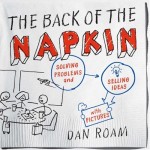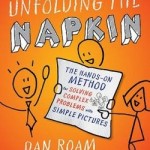Does Teasing Your Brain Make it Stronger?
 There is some evidence that we can enhance our brain function and cognitive performance by regularly solving puzzles, problems, riddles or games that tease our brain. Teasing means presenting some enjoyable mental challenge that is not too easy but not too hard.
There is some evidence that we can enhance our brain function and cognitive performance by regularly solving puzzles, problems, riddles or games that tease our brain. Teasing means presenting some enjoyable mental challenge that is not too easy but not too hard.
Classic crossword puzzles and the more recent Sudoka number-pattern puzzles are popular brain teasers. Some people love them others find them boring.
The key is to find the type of brain teaser you enjoy and enjoy it regularly.
If you have not discovered your inner brain teaser, or are shopping for new ones (always a good idea), check out Top 10 Brain Teasers and Games for Adults and Kids from Sharpbrains. You are sure to find something you like. If you do, the next challenge is find a steady supply of similar challenges.
Very interested to hear from readers that enjoy brain teasers. How do they enhance cognitive function?
Image Source: Fanpop!
Categories: Cognitive Decline, Lifestyle, Mental Focus, Perception, Problem Solving Tags: games
Reclaim Your Divergent Thinking Talents
Many older adults worry about memory loss. This is a serious issue especially if it leads to dementia and the inability to do the activities of daily living.
But just as serious, and more so in many ways, is the dramatic loss of divergent thinking skills in young children.
One long-term study found that in a group of 1600 children those that ranked tops in divergent thinking dropped dramatically with age. Specifically, those achieving a top score for divergent thinking went from 98% in kindergarten to 32% five years later to just 10% when they reached early teens. Divergent thinking is a natural talent and is rapidly educated and socialized away.
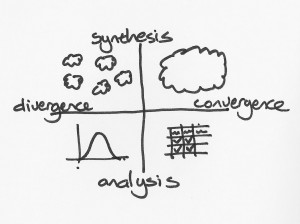 Divergent thinking is the capacity to see multiple options, alternatives or possibilities. The goal is not to find a solution but instead find an enormous range of potential and therefore very different solutions. For example, how many interesting uses can you find for a rubber band? On average people might find 10-20, genius level performance would generate in excess of 150. The trick to generating many more options is to begin to relax assumptions about what a rubber band is. What if it was a mile long? Of course, some would claim that is cheating, as we have all been taught to do. Just as there is one right answer so why worry about so many?
Divergent thinking is the capacity to see multiple options, alternatives or possibilities. The goal is not to find a solution but instead find an enormous range of potential and therefore very different solutions. For example, how many interesting uses can you find for a rubber band? On average people might find 10-20, genius level performance would generate in excess of 150. The trick to generating many more options is to begin to relax assumptions about what a rubber band is. What if it was a mile long? Of course, some would claim that is cheating, as we have all been taught to do. Just as there is one right answer so why worry about so many?
The question is how can we reclaim our genius level of performance in divergent thinking? How can we then channel it into creative expression and break-through problem solving?
Mind mapping, journaling and traditional brainstorming are techniques that are typically offered to those looking to build divergent thinking skills.
Start simple with brainstorming by yourself but apply it to a practical problem that means something to your right now.
Here is what you do. Let’s say you are buying a new computer. Use divergent thinking to decide what to do with the old one. Set a time limit (say 20 minutes at most), and list as many ideas as you can. Best to write them down. Go for the largest number, don’t worry if they are good/bad, look at how you can combine ideas and allow for the weird and strange. Have fun with it. Open up your mental jets.
 With continued practice your mind will get use to this mode of thinking again and you will start to reclaim your divergent thinking talent. Consider using mind mapping or some other way of seeing how your ideas related to each other visually. Include others. Let alternatives bubble up all day or all week and capture them in a journal as you go. Soon your thinking will diverge far and fast when you want it to. The payoff? Good ideas that you would have normally never even considered.
With continued practice your mind will get use to this mode of thinking again and you will start to reclaim your divergent thinking talent. Consider using mind mapping or some other way of seeing how your ideas related to each other visually. Include others. Let alternatives bubble up all day or all week and capture them in a journal as you go. Soon your thinking will diverge far and fast when you want it to. The payoff? Good ideas that you would have normally never even considered.
Interested to hear form readers that practice divergent thinking. What techniques do you use?
Categories: Lifestyle, Problem Solving, Training Tags: creativity, processing speed
Putting Science into the Art of Brainstorming
 I get email from readers asking about how to run brainstorming sessions. These are group meetings that are designed to come up with creative new ideas on hard problems. Many times such meeting can be a disappointment. The questions is – what specific practices can we use to improve group cognitive performance during brainstorming? Just the stuff we want to discuss on the Next Brain Blog.
I get email from readers asking about how to run brainstorming sessions. These are group meetings that are designed to come up with creative new ideas on hard problems. Many times such meeting can be a disappointment. The questions is – what specific practices can we use to improve group cognitive performance during brainstorming? Just the stuff we want to discuss on the Next Brain Blog.
North Carolina University just released a comprehensive study that Finds Brainstorming Rules Can Lead to Real-World Success in Business Settings.
“The study found that there are 21 specific best practices that contributed to successful brainstorming efforts, and that the benefits of high quality brainstorming could be attained when at least 10 to 11 of those practices are put into place – such as the inclusion of subject-matter specialists and an openness to input from all team members.”
This is one of the few empirical studies I have found that shows the quality of brainstorming can impact group decision-making. You can find the details in a free draft version of the paper. They quote a lot of interesting research some of which flies in the face of normal practice. For example:
“More importantly, contemporary experimental research by Lynch et al. 2009 and Hunton and Gold 2010 find that the brainstorming methods that are predominant in practice e.g., face-to-face communication and open brainstorming are less effective than alternative methods e.g., electronic communication and round robin brainstorming.”
Categories: Decision Making, Problem Solving, Training Tags:
A Philosophical Method For Next Level Thinking
On the Next Brain blog we explore specific techniques for improving brain function and cognitive performance. We report on techniques from any field where excellence in thinking, learning, perception, memory, creativity, decision-making and other mental functions are known to take place. For example, consider the field of philosophy. Philosophers are known for their ability to think deeply and clearly about the most complex topics. What can we learn from them to enhance our cognitive performance?
One technique that you can pick up fairly quickly and use nearly every day is call the Toulmin Method. This is a method for analyzing text or verbal statements and abstracting any argument that is being made. Making the claim, reasons and justification for an argument clear is a key step in being able to think analytically about a topic rather than just going with our gut instinct.
Colorado State University has developed an excellent guide to The Toulmin Method. In short and simple language it breaks down the parts to an argument, explains how to see them in everyday circumstances and even provides a worksheet to apply the method.
It should take no more than 45 minutes to work through the site including the student example. You can pick a newspaper story, blog post, memo from work or passage from a book you are reading and try and apply it. Keep using it and you will see how the depth and intellectual clarity you have around key issues and arguments improves. You might even find yourself changing your mind on important matters!
Interested to hear from readers that use the Toulmin Method or any other technique for making arguments explicit and analyzing them.
Categories: Decision Making, Problem Solving, Training Tags: critical thinking
Short Walks Weekly Improve Intelligence
40 Minute Walks 3 Times Per Week at Your Own Pace Measurably Boost Brain Function.
In response to an early post a reader sent me a link to this article – A gentle Stroll can Boost Intelligence. It reports on a study conducted with 100 sedentary adults (self-confessed couch potatoes) that started to walk regularly at their own pace 3 times a week for six months. To make the study interesting the researchers had part of the group do the walking and others do stretching and toning exercises. Here is what they found:
“The walkers also had increased connectivity in the part of the brain which helps in the performance of complex tasks and they did significantly better on cognitive tests than their toning and stretching peers.”
This means mild aerobic exercise can change the wiring of your brain and improve cognitive performance. The effect was especially pronounced in the older adults in the study.
Categories: Lifestyle, Older Adult, Problem Solving Tags: exercise
14 Research Proven Ways to Improve Creativity
 The PsyBlog recently published a couple of posts outlining 14 techniques with supporting psychological research for being more creative. The posts are:
The PsyBlog recently published a couple of posts outlining 14 techniques with supporting psychological research for being more creative. The posts are:
I won’t repeat the techniques here as they are described and referenced well in the posts. They are worth a read and some experimentation.
I guarantee you will find at least 2 or 3 techniques you have not tried before.
Interested to hear from readers on specific techniques for boosting creativity.
Categories: Problem Solving, Training Tags: creativity
Solve Problems and Learn While You Sleep?
 We spend a good part of our life sleeping and dreaming. Getting adequate quality sleep is essential for brain health. But we may be able to go farther than that and tune how we sleep to enhance cognitive performance. Lucid dreaming, subliminal learning and cognitive priming are three techniques that have been suggested for getting more out of our brains even while we sleep. We will cover these topics as well as how sleep in general impacts peak cognitive performance on the Next Brain Blog.
We spend a good part of our life sleeping and dreaming. Getting adequate quality sleep is essential for brain health. But we may be able to go farther than that and tune how we sleep to enhance cognitive performance. Lucid dreaming, subliminal learning and cognitive priming are three techniques that have been suggested for getting more out of our brains even while we sleep. We will cover these topics as well as how sleep in general impacts peak cognitive performance on the Next Brain Blog.
Cognitive priming is my personal favorite. I have done it with good results for nearly two decades. I have never seen any scientific studies (until now) that back it up.
Cognitive priming to improve performance through sleep is simple to do. You intensely immerse yourself in the topic to learn or problem to solve near bedtime. When you sleep you want to have a dream about the problem or topic. Upon waking you should be able to make much better progress on the topic or problem than you could have if you did not dream about it.
I was happy to hear that such phenomenon was demonstrated under scientific conditions in a a recent study at the Beth Israel Medical Center. I was reported on in the New York Times as Learning While You Sleep. Volunteers were given the task of learning to move through a complex maze. After a training period some of the group slept for 90 minutes and the others just rested.
Re-testing revealed that those that slept and dreamt about the maze had a 10 times improvement in score while those that slept but did not dream or just rested showed no improvement or even a a worse score.
Categories: Memory and Learning, Problem Solving, Sleep, Training Tags:
Fast, Free and Fun Cross-Training for Your Brain
 Crossword puzzles, a quick round of Sudoku, spot the difference, cryptograms or dozens of other short single-player games turn out to be a great way to improve memory, mental focus, problem solving ability and a host of other cognitive functions. They are a bit old school compared to the new brain games engineered on the latest neuroscience but research shows they can be just as effective!
Crossword puzzles, a quick round of Sudoku, spot the difference, cryptograms or dozens of other short single-player games turn out to be a great way to improve memory, mental focus, problem solving ability and a host of other cognitive functions. They are a bit old school compared to the new brain games engineered on the latest neuroscience but research shows they can be just as effective!
For a great collection of free, short and single player games and puzzles that will build your brain check out Smart Kit. The variety on this site is amazing. That is the key. You should be able to easily find one that is fun and when it gets boring there will be another waiting for you! The idea is to immerse yourself in a variety of short games and puzzles that cross-train your brain.
Interested to hear from readers that do any form of online cross-training for the brain. What products and sites do you use?
Categories: Memory and Learning, Mental Focus, Perception, Problem Solving, Software Tags: games
Build Problem Solving Skills with Visual Thinking
Drawing a diagram can be a powerful problem solving technique. Creating a visual representation forces our brain to process information in a specific way and it provides something new for us to see or perceive. Any technique, no matter how simple, that cause us to think differently and see differently holds the promise for improving problem solving and creativity.
Visual techniques designed to systematically stimulated improved thinking will be a frequent topic on the Next Brain Blog. Take for example, the recent work by Dan Roam. He has two books on on using visual thinking including The Back of the Napkin and Unfolding the Napkin.
His work is based on a four-step approach to visual thinking including look, see, imagine and show.
If you want to a jump-start on Roam’s approach to visual thinking, check out this 8-page BPTrends review of the Back of the Napkin.
I am interested to hear from readers that have used visual thinking techniques to improve problem solving, creativity or other aspects of cognition.
Categories: Books, Executive, Leader, Perception, Problem Solving, Professional, Software, Training Tags: creativity
Build Your Brain By Making Better Arguments
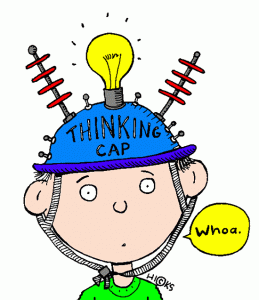 Making formally sound and psychological convincing arguments is hard mental work. It is a form of critical reasoning and therefore practicing it is a great technique for improving your thinking (cognitive) skills. Argumentation and how to use it to improve cognitive performance will be a frequent topic on the Next Brain Blog.
Making formally sound and psychological convincing arguments is hard mental work. It is a form of critical reasoning and therefore practicing it is a great technique for improving your thinking (cognitive) skills. Argumentation and how to use it to improve cognitive performance will be a frequent topic on the Next Brain Blog.
We can learn how to make good arguments much as we can learn to make good food, music or art. It takes an understanding of the fundamentals of argumentation, tons of practice and taking on new and challenging situations regularly. Fortunately, the fundamentals of argumentation are clear, there are many opportunities to constructively practice at home, work and in the community and new challenges are presented to us daily.
Getting started in the art of argument requires a clear statement of the point you want to make (the conclusion) as well as a clear statement of what justifies it (premises).
Just writing down your premises and conclusion can be a difficult challenge but one that adds enormously to the clarity of thought.
A good argument is one where the conclusion can be logically inferred from the premises, is free of logical fallacies, anticipates and deflates counter arguments, has well-justified premises and clearly delineates factual claims from opinions.
For a great introduction to the ideas of formal and informal validity of arguments check out the post, What Makes a Good Argument? on the Thinking Matters Blog. It covers the 9 types for formal validity you are likely to use as well as 8 common informal mistakes you are likely to commit.
You can show that your argument is formally valid by demonstrating the conclusion (Q) follows from the premises (P) using one or more of the rules of deductive logic. For example, one rule is called modus ponens (and I quote from Thinking Matters):
“Modus ponens is Latin. It means “the mode which affirms”. Knowing the English translation makes it very easy to follow:
- P –> Q
- P
- Q
In plain English: if P, then Q; P, therefore Q. “P” and “Q” represent propositions, so it’s helpful to substitute in simple phrases for them, to get a better idea of what the rule is saying. For example, let P mean “it is raining”, and let Q mean “the ground is wet”. So:
- If it is raining, then the ground is wet.
- It is raining.
- Therefore, the ground is wet.
As you see, this is really a very simple and obvious rule—as you’ll find that all the fundamental rules of logic are.”
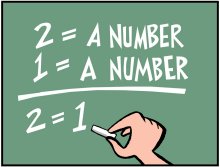 Formal validity is not enough. Your argument must also must avoid falling into a logic trap. For example, consider the argument from ignorance (quoting from Thinking Matters):
Formal validity is not enough. Your argument must also must avoid falling into a logic trap. For example, consider the argument from ignorance (quoting from Thinking Matters):
“Arguing that a belief is false because there is insufficient evidence for it.
- No one can disprove the existence of God. Therefore, God exists.
- There’s no evidence that the Red Sea was ever parted. Therefore, the account in Exodus is a myth. (Notice, though, that an argument saying that there is evidence that the Red Sea was not ever parted would not be fallacious.)”
I have heard many arguments made this way. It may take you an hour or so to work through all 17 principles and really understand each one. However, it is well worth your time. With a basic understanding you can use them as a quick checklist to refine the clarity, power and validity of your arguments.
I am interested to hear from readers that practice the art of argumentation and how it has impacted your effectiveness as a thinker.
Sources: Image of Thinking Cap, Image of Logical Fallacy
Categories: IQ and EQ, Problem Solving, Training Tags: critical reasoning, critical thinking



